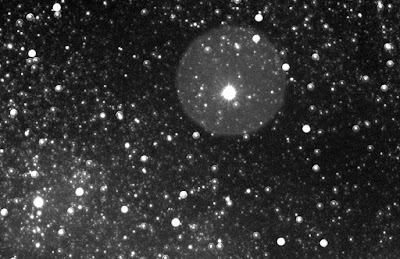 |
| IC63 and IC59 |
Object: IC59, 63 (Sharpless 2-185)
Type: Emission and reflection nebulae
Constellation: Cassiopeia
Distance: 600 light years
Equipment: ATIK 460EX with EFW2, Skywatcher f5.5 Esprit 100 ED refractor, Avalon Linear mount, guiding with Lodestar X2/PHD
IC63 (the bright, pointed object near the middle of the image) and IC59 (the fainter bluish area above and to the upper right) are the brightest areas of the nebulosity known as Sharpless 2-185 (Sh2-185). They were discovered independently by Max Wolf (Dec 30, 1893) and Edward Barnard (Feb 2, 1894).
Together, the nebulae occupy an area of space approximately 10 light-years across.
The bright, hot star Gamma Cassiopeia (seen at the bottom right of the above image) is located only 3 or 4 light-years from the nebulae, and it may have shed this nebulous material into the space around it. The edges of the nebulae glow brightly from this intense radiation that is slowly evaporating and lighting up these flowing shapes of gas and dust
Gamma Cassiopeia has a radius 14 times greater than our Sun and is 55,000 times more luminous, 19 times more massive, and rotates at about 300 km/hour, or 150 times more rapidly than our Sun. It is known as an eruptive blue-white sub-giant variable star. (Eruptive variable stars vary in brightness because of violent processes and flares in their coronae and chromospheres.)
This star is an erratic variable that reached a maximum brightness in 1937, but then unexpectedly dropped in surface temperature from 12,000°K to 8500°K. It is encircled by a surrounding gaseous disk of material thrown off by its rapid rotation. Mass loss is apparently related to the brightness variations.
 |
| Stellarium map showing image field |
As can be seen above, the two nebulae have very different visual appearances. IC63 can be referred to as a "cometary cloud", is pointing toward Gamma Cas, and is narrower and more sharply defined than IC59. Spectral measurements suggest that IC59 is slightly cooler at 590K and less dense than IC63 at 630K. They are not actually separate nebulae, but are part of a much larger nebulous region surrounding Gamma Cas based upon the WHAM (Wisconsin H-alpha Mapper) survey. IC63 has bright filaments, visible in the image above, that are believed to be ionized fronts of gas created by Gamma Cas, and seen by us as nearly edge-on.
Both nebulae exhibit spectroscopic evidence from the mid-infrared of molecular hydrogen and polycyclic aromatic hydrocarbons (PAH). The contrast in appearance between IC63 and IC59 is consistent with a difference in actual distances from Gamma Cas and small differences in temperature and column density..
There is some discussion in professional circles as to whether the H-alpha signal that we pick up in our images is actual emission from the nebula, or a reflection of the H-a emitted from Gamma Cas that is scattered by the dust in IC59 and IC63. This light scattering and reflection is called ERE, (Extended Red Emission). Gamma Cas is the prototype B0 IV star, emitting significant H-a. It is above the main sequence with a more extended atmosphere. Being somewhat cooler than a BO V star, it is only marginally capable of ionizing molecular hydrogen in its vicinity. Thus, it is possible that the H-a we pick up in our images is a mixture of both processes; direct H-a emission from ionization, and ERE.
H-alpha data was gathered on the bright moonlit evenings of 2-4 November. The bright (and damp!) conditions were not ideal for the imaging of what is quite a faint nebula, but given that the previous month’s skies had been completely clouded out, it seemed best to make do. All three evening sessions were ended at around midnight due to high haze and mist setting in, and the resultant image stack suffered from background noise.
Application of Starnet++ to the Ha stack allowed the nebulosity to be stretched and smoothed, with stars from the “unstretched” stack being pasted back in in “screen” mode to avoid star bloat.
Colour data was acquired on 15-16th November, with the moon mercifully absent: the imaging session was still stop-start due to clouds and was finally clouded out at around 2.00 am.
The blue reflection nebulosity was pretty faint but once again Starnet++ allowed separation of the nebulosity from stars for processing purposes. The Ha data was blended in with the red channel and the blend used in an RGB composite in PSP. A partial luminance overlay of Ha was used to sharpen the image up a bit.
References:
2. NASA APOD
4. https://cseligman.com/text/atlas/ic0a.htm































